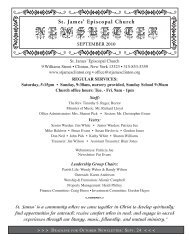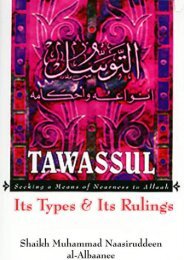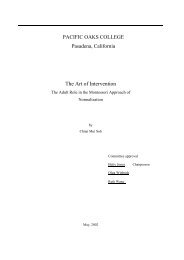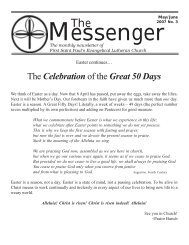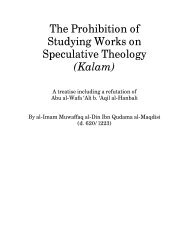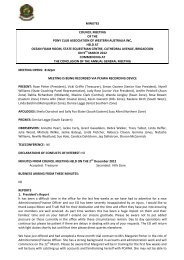Scripture and God in Christianity
Scripture and God in Christianity
Scripture and God in Christianity
Create successful ePaper yourself
Turn your PDF publications into a flip-book with our unique Google optimized e-Paper software.
which ascend to the light, there come forth all sorts of hideous reptiles <strong>and</strong> a host of rats <strong>and</strong><br />
mice....There probably never was an age <strong>in</strong> which Christendom was free from this " <strong>Christianity</strong>",<br />
just as there never will be one <strong>in</strong> which it shall have been overcome." 776<br />
Jesus Christ the <strong>in</strong>carnate <strong>God</strong> was also the son of Mary. Incarnation <strong>and</strong> then the early Church<br />
Father's usage of terms like 'the Bearer of <strong>God</strong>' 'Theotoka or Mother of <strong>God</strong>' promoted worship<br />
of Mary, a mere human be<strong>in</strong>g. "But Mary obta<strong>in</strong>ed her chief, her positively dogmatic significance<br />
from the fact that the dogma of the Incarnation became the central dogma of the Church." 777<br />
Nestorius cried <strong>in</strong> va<strong>in</strong> to Cyril <strong>and</strong> to the Church <strong>in</strong> general, "Do not make the Virg<strong>in</strong> <strong>in</strong>to a goddess."<br />
It is an outrageous <strong>in</strong>novation. But, as observes Don Cupitt, "It br<strong>in</strong>gs out an odd feature of<br />
<strong>Christianity</strong>, its mutability <strong>and</strong> the speed with which <strong>in</strong>novations come to be vested with religious<br />
solemnity to such an extent that any one who questions them himself regarded as the dangerous<br />
<strong>in</strong>novator <strong>and</strong> heretic." 778 Nestorius was declared a heretic <strong>and</strong> Mary was exalted above<br />
all creatures, above Cherubim <strong>and</strong> Seraphim <strong>and</strong> got the position at the right h<strong>and</strong> of the Son.<br />
The reason, as is clear from the statement of John of Damascus, is that " The name `Bearer of<br />
<strong>God</strong>' represents the whole mystery of the Incarnation. The Holy Spirit purified Mary with a view<br />
to the conception." 779 She was worshipped, called upon <strong>in</strong> prayers for support <strong>and</strong> help <strong>and</strong> her<br />
pictures <strong>and</strong> images were worshipped. Comment<strong>in</strong>g on this development Harnack observes, "Pictures<br />
of Christ, Mary <strong>and</strong> the sa<strong>in</strong>ts, had been already worshipped from the fifth (fourth) century<br />
with greet<strong>in</strong>gs, prostration, a renewal of ancient pagan practices. In the naive <strong>and</strong> confident conviction<br />
that Christians no longer ran any risk of idolatry, the Church not only tolerated, but promoted,<br />
the entrance of paganism. It was certa<strong>in</strong>ly the <strong>in</strong>tention to worship the div<strong>in</strong>e <strong>in</strong> the material;<br />
for the <strong>in</strong>carnation of deity had deified nature (ousia)" 780<br />
In addition to the above mentioned problems, the doctr<strong>in</strong>e of Incarnation taken literally could<br />
lead to <strong>God</strong>'s depiction <strong>in</strong> concrete corporeal human images. Don Cupitt rightly observes that "If<br />
it is the case that <strong>in</strong> the <strong>in</strong>carnation <strong>God</strong> himself has permanently assumed human nature, <strong>and</strong> can<br />
legitimately be depicted as <strong>God</strong> <strong>in</strong> human form, then eventually the ultimate mystery of deity will<br />
be conceived anthrpomorphically, <strong>and</strong> the pagan notion of a deity as a superhuman person with<br />
gender will be restored. In due course this happened, aided by the traditional Father-Son imagery."<br />
781 In the East the Church showed reservation <strong>in</strong> this matter <strong>and</strong> permitted only the depiction<br />
of the Deity <strong>in</strong> a human form different from the human form of Christ <strong>in</strong> the st<strong>and</strong>ard iconography<br />
of scenes like Baptism, where a h<strong>and</strong> emerges from the cloud to release the dove upon<br />
Jesus' head. But after the sixteenth century, under the <strong>in</strong>fluence of the West, images of <strong>God</strong> appeared<br />
<strong>in</strong> the East. The West has been less conservative <strong>in</strong> this regard. The anthropomorphic images<br />
of <strong>God</strong> became very common <strong>in</strong> the West after about 1100. 782 Don Cupitt is quite right <strong>in</strong><br />
protest<strong>in</strong>g aga<strong>in</strong>st these developments: "It is my contention that the doctr<strong>in</strong>e of Christ as <strong>God</strong>'s<br />
div<strong>in</strong>e Son has here humanized deity to an <strong>in</strong>tolerable degree. The strangeness of it is seldom noticed<br />
even to this day. A sensitive theologian like Aust<strong>in</strong> Farrer can dwell eloquently upon a medieval<br />
icon of the Tr<strong>in</strong>ity, <strong>and</strong> a philosopher as gifted as Wittgenste<strong>in</strong> can discuss Michelangelo's<br />
pa<strong>in</strong>t<strong>in</strong>g of <strong>God</strong> <strong>in</strong> the Sistene Chaple, <strong>and</strong> <strong>in</strong> neither case is it noticed there could be people to<br />
whom such pagan anthropomorphism is abhorrent, because it signifies a 'decl<strong>in</strong>e of religion' <strong>in</strong><br />
the only sense that really matters, namely, a serious corruption of faith <strong>in</strong> <strong>God</strong>." 783<br />
96





